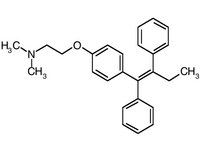A new analysis of U.S. cancer data by the National Cancer Institute (NCI) indicates that more than 2 million American women could benefit from taking the drug tamoxifen to prevent breast cancer.
As with all medicines, tamoxifen has side effects that may affect some women and not others. With tamoxifen, the effects are rare, but serious. The study, published in the April 2, 2003, issue of the Journal of the National Cancer Institute, weighed these risks, which are especially high for older women, against the benefits of tamoxifen to determine how many women in the United States are likely to have a net benefit from the drug.
Tamoxifen was approved as a chemoprevention drug for breast cancer by the FDA in 1998, after the NCI released the results of the Breast Cancer Prevention Trial (BCPT), a six-year study of the drug. In BCPT, tamoxifen was found to reduce the incidence of breast cancer by 49 percent. Based on that study, the FDA approved the drug for women at high risk of developing invasive breast cancer.
Using data on cancer risk factors from the 2000 National Health Interview Survey, Andrew N. Freedman, Ph.D., and colleagues at the NCI calculated the number of U.S. women eligible to take tamoxifen based on FDA-approved indications. They also projected the number of white and black women who would most likely have a net positive benefit from taking the drug based on a benefit-risk analysis. Because accurate data on the frequency of adverse tamoxifen effects in Hispanic women were not available, estimates of how many Hispanic women would likely benefit from the drug could not be calculated, Freedman says.
The researchers estimated that 15.5 percent of women 35 to 79 years old in this country, or about 10 million, would be eligible to take tamoxifen based on breast cancer risk alone.
The decision to take tamoxifen will depend on a woman's age, breast cancer risk factors, family history, how she weighs the benefits and risks, and her specific medical situation, lifestyle, personal values, and preferences, says Worta McCaskill-Stevens, M.D., one of the co-investigators on the NCI study.
"Women with increased risk of breast cancer must carefully consider the benefits and risks in consultation with their physicians," says Freedman.
When analyzed by race, 18.7 percent of white women ages 35 to 79 in the United States, or 9.4 million, would be eligible for tamoxifen, but only 4.9 percent, or 2.4 million, are likely to benefit from the drug. About 6 percent of U.S. black women in the same age range, or 430,000, would have a high enough risk to take the drug, but only 0.6 percent, or 43,000, would likely derive a net benefit from it. The rates are lower for black women than white women, Freedman says, because the overall risk for breast cancer in black women is lower and because the rates of stroke, deep vein thrombosis, and pulmonary embolism are higher among black women than among white women.
The researchers found that younger women are less likely than older women to experience the drug's adverse affects. This means that if a 40-year-old woman and a 60-year-old woman had the same breast cancer risk, the younger woman would likely derive a better overall benefit from the drug.
For more information, go to the NCI's Web site, http://cancer.gov/ bcrisktool/, or call the NCI's Cancer Information Service at 1-800-4-CANCER (1-800-422-6237).
COPYRIGHT 2003 U.S. Government Printing Office
COPYRIGHT 2004 Gale Group



